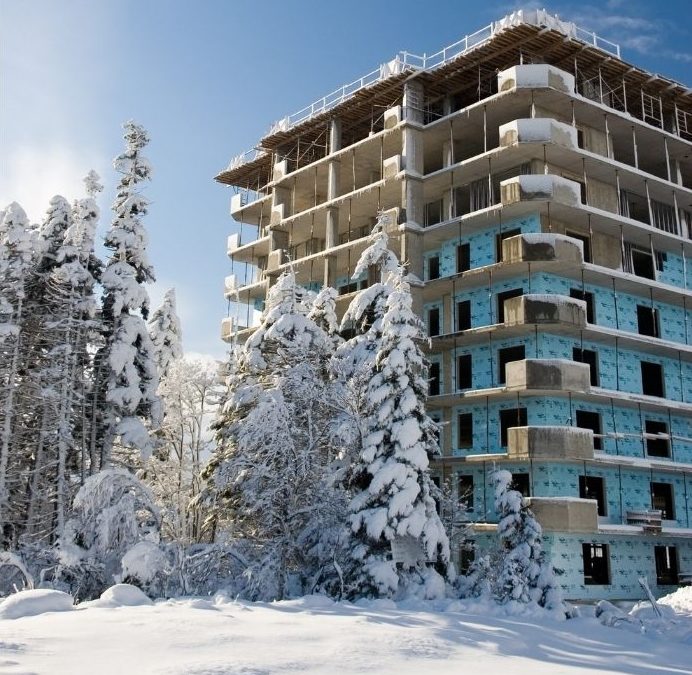Winter is coming, and for many crews this means that business is about to significantly slow down. This can hurt the bottom line of the construction company, and affect the paycheck of several employees. But, what if you didn’t have to stop constructing just because Jack Frost is making an appearance?
Cold-formed steel is the proven solution to keep your project moving during the cold winter months, it is a material that is easy to design and solves a lot of weather-related problems on the jobsite.
Here are four reasons to use cold-formed steel for your winter projects. There is no need to halt construction during the winter months… we will tell you why!
1. No Heat Required!
A lot of construction project materials require you to have heat available. In fact, there are some materials that simply can’t be used in cold temperatures. Even suppliers that work with concrete and similar materials will raise their prices for the winter.
Concrete is a material that requires curing time before a load can be applied. When it is cold, that curing time is drastically longer than when it is hot outside. Contractors often have to pay a higher bill to even get delivery. Once the concrete is laid, they have to bring in heating equipment and put together a setup that will heat the concrete so that it can set properly.
This means additional overhead costs and additional time in order to be able to move forward with your project.
The good news is that cold-formed steel doesn’t need heat. There are absolutely no temperature or humidity requirements to work with cold-formed steel and it is effective every time!
2. Structurally Sound Despite the Cold
Cold-formed steel is formed cold through a process that uses a machine to press the cold coils into the shapes of cee-studs, tracks, z-purlins, clips, etc.
Cold-formed steel shapes are often formed at a roll-former/manufacturer and sent to the jobsite cut and formed to the exact specifications. But, in some cases cold-formed steel can be formed on a jobsite. Since the cold-formed process doesn’t require any special temperatures, it makes cold-formed steel one of the most versatile project materials available.
Cold-formed steel erection can also be scheduled anytime of the year, so it’s a great way to keep multi-seasonal projects on track! CFS isn’t going to twist or warp, so it doesn’t matter if there is moisture or cold. It is a structurally sound material that will remain as it should, and is primarily unaffected by the cold or wet elements that accompany most winters.
Let’s compare cold-formed steel to concrete again…
Did you know that it is imperative for concrete not freeze for the first 24 hours after it has been laid? So, if you use concrete in winter temperatures you will be forced to find a means to make sure it stays “unfrozen” or else you’ll be facing a multitude of construction problems.
The same is true of masonry work. If you’re using bricks, the mortar used to lay them absolutely cannot freeze. Contractors using these materials in cold temperatures have to monitor the weather situation closely, and then for a specific time period afterwards.
Thankfully, cold-formed steel has no such requirements.
10-story panelized CFS project in Bloomington, MN
3. Stay on Track
Cold-formed steel is often used to construct load-bearing walls, curtainwalls, floors, and roofs. It could be the solution you are seeking as a means to keep your winter project on schedule! Since all projects have deadlines, when work gets pushed back because of Mother Nature that can really hurt the bottom line. And since many construction jobs are multi-seasonal, it’s vital that those projects stay on track.
If concrete or masonry is needed, crews should plan to get that part of the project prepped and ready so you can continue building during the cold winter months with your CFS materials. The primary foundation can typically be set ahead of time and then you will be able to work through the winter using CFS.
This will save you time, keep your project on schedule, and it will likely save you and your business big money instead of trying to carry the contract over until it is warm again.
4. Support Other Trades
Another reason to consider using cold-formed steel during the winter is that you are also helping to support other trades. Your ability to maintain a multi-seasonal project provides work for people like mechanics, plumbers, and engineers who historically find it more difficult to secure work during the winter months.
Conclusion
There you have it… a few more reasons why you should consider CFS on your next project.
Cold-formed steel is the perfect material to conquer winter construction. With its lower costs, plenty of versatility and the ability to adapt to any weather condition, CFS is sure to not give you any winter-time blues!


 10-story panelized CFS project in Bloomington, MN
10-story panelized CFS project in Bloomington, MN
Recent Comments